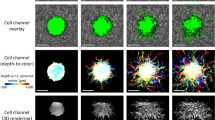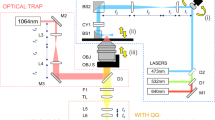Abstract
Here we integrated multiphoton laser scanning microscopy and the registration of second harmonic generation images of collagen fibers to overcome difficulties in tracking stromal cell-matrix interactions for several days in live mice. We show that the matrix-modifying hormone relaxin increased tumor-associated fibroblast (TAF) interaction with collagen fibers by stimulating β1-integrin activity, which is necessary for fiber remodeling by matrix metalloproteinases.
This is a preview of subscription content, access via your institution
Access options
Subscribe to this journal
Receive 12 print issues and online access
$259.00 per year
only $21.58 per issue
Buy this article
- Purchase on Springer Link
- Instant access to full article PDF
Prices may be subject to local taxes which are calculated during checkout



Similar content being viewed by others
References
Grinnell, F. Trends Cell Biol. 13, 264–269 (2003).
Tomasek, J.J., Gabbiani, G., Hinz, B., Chaponnier, C. & Brown, R.A. Nat. Rev. Mol. Cell Biol. 3, 349–363 (2002).
Brown, E. et al. Nat. Med. 9, 796–800 (2003).
Halin, C., Rodrigo Mora, J., Sumen, C. & von Andrian, U.H. Annu. Rev. Cell Dev. Biol. 21, 581–603 (2005).
Wolf, K., Muller, R., Borgmann, S., Brocker, E.B. & Friedl, P. Blood 102, 3262–3269 (2003).
Fukumura, D. et al. Cell 94, 715–725 (1998).
Samuel, C.S., Hewitson, T.D., Unemori, E.N. & Tang, M.L. Cell. Mol. Life Sci. 64, 1539–1557 (2007).
Thevenaz, P., Ruttimann, U.E. & Unser, M. IEEE Trans. Image Process. 7, 27–41 (1998).
Abercrombie, M., Heaysman, J.E. & Pegrum, S.M. Exp. Cell Res. 59, 393–398 (1970).
Friedl, P., Zanker, K.S. & Brocker, E.B. Microsc. Res. Tech. 43, 369–378 (1998).
Zigrino, P. Eur. J. Cell Biol. 80, 68–77 (2001).
Binder, C. et al. Breast Cancer Res. Treat. 87, 157–166 (2004).
Acknowledgements
This work was supported by US National Cancer Institute grants R01-CA98706 (Y.B.), R01-CA85140 and P01-CA80124 (R.K.J.), and fellowship Swiss National Funding for young scientists 107362, Fond Decker and Fond de Perfectionement du Centre Hospitalier Universitaire Vaudois (J.Y.P.). We thank J. Kahn for technical assistance.
Author information
Authors and Affiliations
Contributions
J.Y.P. designed and performed experiments, analyzed data and wrote the paper. T.D.M. conceived the project, designed and performed experiments, analyzed data, and wrote the paper. C.D.L. performed imaging and immunostaining experiments. H.M. performed imaging and analyzed data. M.D. performed flow cytometry analysis. T.P.P. analyzed data and wrote the paper. L.L.M. analyzed data and wrote the paper. R.K.J. coordinated the project and wrote the paper. Y.B. coordinated the project, designed experiments, analyzed data and wrote the paper.
Corresponding authors
Supplementary information
Supplementary Text and Figures
Supplementary Figures 1-4, Supplementary Table 1, Supplementary Methods (PDF 4000 kb)
Supplementary Video 1
Region of interest in which 8 cells are tracked over the 4 day time course. Some cells exhibit projections with no directed movement, while others move a distance of one cell body or greater over the 4 day time-course. Cells of interest are drawn as outlines on the image in yellow, to indicate the extent of each individual cell over time. (MOV 566 kb)
Supplementary Video 2
Collagen fiber interacting with a migrating stromal cell. For each time point, the SHG, GFP and the merged GFP-SHG maximum intensity projection of the acquired volumes are shown on four consecutive days. The bottom panel is a schematic drawing. The collagen fiber is dragged by the migrating stromal cell. Bar = 10 μm. (MOV 267 kb)
Supplementary Video 3
Buckling rearrangement of a collagen fiber by stromal cells in a relaxin treated tumor. For each time point, the SHG, GFP and the merged GFP-SHG maximum intensity projections of the acquired volumes are shown. The bottom panel is a schematic drawing. Relaxin treatment seems to cause a long lasting stromal cell interaction with the collagen fiber eventually leading to buckling of the latter. Bar = 20 μm. (MOV 676 kb)
Supplementary Video 4
Gap formation in a collagen fiber induced by relaxin. For each time point, the SHG, GFP and the merged GFP-SHG maximum intensity projection of the acquired volumes are shown. The bottom panel is a schematic drawing. There is an increased interaction of stromal cells with collagen fibers between day 1 and 2 and fiber thinning and gap formation at later time points. Bar = 20 μm. (MOV 807 kb)
Supplementary Video 5
Global rearrangement of collagen fiber bundles. For each time point, the SHG and the merged GFP and SHG maximum intensity projection of the acquired volumes is represented. From day 2, a group of fibers associated to stromal cells seems to be pushed towards the center of the images. Bar = 25 μm. (MOV 420 kb)
Rights and permissions
About this article
Cite this article
Perentes, J., McKee, T., Ley, C. et al. In vivo imaging of extracellular matrix remodeling by tumor-associated fibroblasts. Nat Methods 6, 143–145 (2009). https://doi.org/10.1038/nmeth.1295
Received:
Accepted:
Published:
Issue Date:
DOI: https://doi.org/10.1038/nmeth.1295
This article is cited by
-
Evaluation of growth-induced, mechanical stress in solid tumors and spatial association with extracellular matrix content
Biomechanics and Modeling in Mechanobiology (2023)
-
Actomyosin contractility-dependent matrix stretch and recoil induces rapid cell migration
Nature Communications (2019)
-
Mechanisms and impact of altered tumour mechanics
Nature Cell Biology (2018)
-
Consensus guidelines for the use and interpretation of angiogenesis assays
Angiogenesis (2018)
-
A cerebellar window for intravital imaging of normal and disease states in mice
Nature Protocols (2017)



